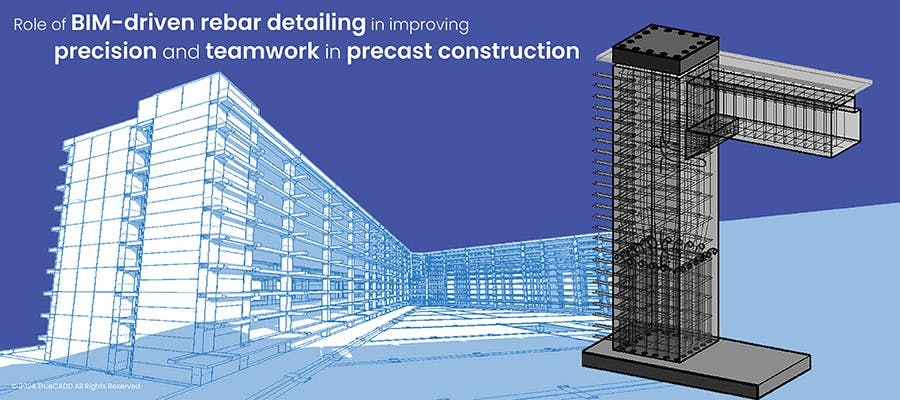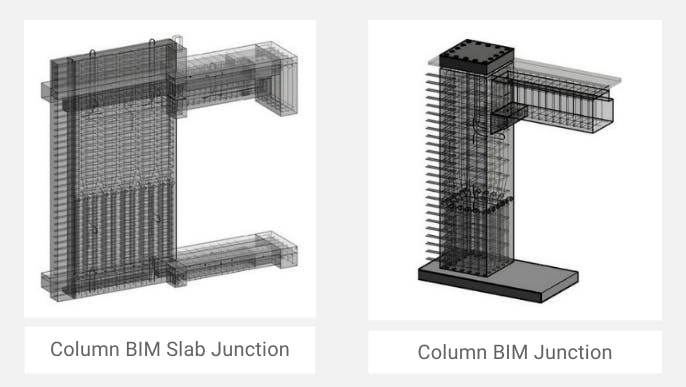How BIM-Enabled Rebar Detailing Enhances Precision and Collaboration in Precast Projects

BIM-based rebar detailing improves precision in precast projects by ensuring material optimization, coordination among stakeholders, and early clash detection. This increases overall construction efficiency, streamlines processes, and enhances project outcomes.
Precast concrete detailing plays a crucial role in structural design as it ensures strength and integrity of reinforced concrete. Detailing requires exact specifications of placement, size, and configuration of reinforced bars to optimize load distribution and prevent structural failure.
Using BIM software for rebar detailing improves precision by offering a digital platform for accurate and comprehensive representation of reinforcement structures. This technology enables meticulous planning, clash detection, and construction efficiency, resulting in precise and well-coordinated rebar detailing in precast construction projects.
What does concrete rebar detailing entail?
Concrete rebar detailing includes the process of generating detailed specifications and drawings to reinforce concrete structures. These details include the size, spacing, placement, and configuration of the reinforcement to ensure durability and structural integrity of concrete members. Precast rebar detailing supports precast/prefab manufacturers in realizing safety standards, design needs, strength, and support for beams, columns, walls, and slabs.
Roadblocks faced by precast/prefab manufacturers
Traditional rebar detailing methods pose challenges for precast and prefab manufacturers, causing unreliability and delays. Manual processes are not equipped to handle complex projects, and can hinder accuracy, productivity and success. Some challenges faced by prefab manufacturers using manual or traditional methods are:
Error-prone and time-consuming process
Miscommunication between different teams
Inability to configure or customize specific design needs
Data silos impede access to and sharing of information
Inaccuracy in data leading to low-quality fabrication of precast components
BIM navigates roadblocks presented by legacy rebar detailing approaches
BIM supports rebar detailing with a digital platform to navigate above challenges and deliver precise, well-coordinated and comprehensive representation of reinforcement structures. This drives higher efficiencies in precast construction projects.
Various BIM capabilities such as construction visualization, simulation, and proper documentation empower prefab manufacturers with precise modeling of beams, walls, slabs, columns, foundation design, frame design, load calculations, and concrete structure modeling.
Rebar quantities from traditional methods are 20.29% greater than the exact required quantities leading to rebar waste.
Source:ThaiScience
While BIM offers numerous advantages for precast manufacturing, enhanced precision and improved collaboration stand out as key efficiency drivers. Let’s understand how the benefits of BIM in pre-fabrication/precast construction drive higher precision and collaboration in rebar detailing for precast manufacturers.
How using BIM in rebar detailing increases precision in precast projects
Accurate estimation of rebar quantities and placement of structural elements
BIM rebar detailing provides accurate quantity estimation by leveraging the digital model's intelligence. The 3D model contains information about the structure's dimensions, elements, and required reinforcement. Algorithms within the BIM software for precast concrete detailing analyze this data, calculating the precise quantities of rebar needed based on the design specifications. This process enhances accuracy in material estimation for construction projects.
Visual 3D modeling for construction also helps provide greater clarity for placement of structural elements, their alignment, and integration with other components. This results in an efficient process that reduces errors and enhances accuracy of rebar quantity takeoff.
Adding a typical list of elements
Rebar detailing driven by BIM improves accuracy through a seamless integration of structural elements within a cohesive model. By incorporating a comprehensive list of typical elements within the digital model, accurate specifications for each rebar component are derived, ensuring consistency and eliminating errors during the detailing process. This methodology allows for the creation of a standardized and comprehensive list of elements to streamline rebar detailing project workflows.
Assign unique ID for precise erection sequence
BIM-based rebar detailing improves accuracy and precision by assigning unique IDs to structural elements for seamless erection sequencing. This method ensures complete coordination to reduce errors during assembly. Unique identifiers encourage seamless management and tracking throughout the complete lifecycle, ensuring efficient coordination and communication amongst project participants. This results in optimized resource use, minimal rework, and error-resistant rebar detailing, leading to higher project quality and success.
Verification of compliance with structural requirements
Rebar detailing enriched by BIM has greater accuracy and precision in verifying compliance with structural requirements by providing a digital model that integrates detailed information on rebar placement and specifications. This allows for thorough analysis and validation against design and structural standards, ensuring accurate compliance checks and minimizing errors during the verification process.
It also helps in planning the strategic use of structural elements leading to improved structural integrity, reduced conflicts, and increased overall project efficiency. This results in a correct and precise representation of the structure to reduce risks and ensure complete compliance based on industry structural standards.
Reduction of manual errors
BIM lowers the risk of manual errors within structural design and detailing. Utilizing information-rich 3D BIM models ensures accurate alignment and placement of rebar components. Automation via Revit and Dynamo within BIM for prefabricated and precast construction, cuts down on human input, thus decreasing the chance of even the slightest miscalculations that could happen with human intervention. BIM improves precision, streamlines detailing, and reduces any potential human errors, ensuring efficient and reliable detailing within modern construction.
Parametric capabilities offered through BIM also facilitate accurate schedules, dimensions, and quantities for reinforcement elements. Prefab and precast manufacturers can utilize BIM models to reduce manufacturing errors and enhance overall component quality based on project specifications.
Improved design validation
BIM-based rebar detailing enhances precision through improved design validation by allowing for comprehensive analysis and simulation of rebar configurations within the digital model. This enables engineers to identify potential design flaws or conflicts early in the process, ensuring that the final design meets structural requirements with greater accuracy and reliability.
With enhanced accuracy and validation of structural designs, precast manufacturers and prefabricators get a precise depiction of building components while being able to examine the intricate connections within structural elements. This analysis aids in refining the reinforcement workflow, leading to an efficient design phase and speeding up the rebar production with high accuracy.
Minimization of rework during construction
Rebar detailing is optimized through BIM by leveraging 3D models of structural members. The digital model enables accurate planning and coordination, reducing the likelihood of errors in rebar placement. This precision in design and documentation simplifies communication and coordination and helps avoid costly rework, ensuring construction progresses smoothly and efficiently.
BIM employs real-time collaboration between project participants to ensure seamless reinforcement of rebar design into the overall project model. Automation with clash detection and accurate QTOs also improve effectiveness and efficiency. Based on a comprehensive digital model for rebar configurations, BIM reduces ambiguities, enhances coordination, and reduces the need for onsite changes to reduce cost and time during the construction phase.
Clash coordination and extracting drawings and BOQs from 3D models
Rebar detailing enriched by BIM workflows and tools like Revit, Navisworks, and other advanced platforms supports accuracy of structural elements based on meticulous clash coordination and resolution. Identifying and resolving conflicts in the design phase through coordination of 3D models and immersive visualization of rebar placement helps with the extraction of detailed drawings and precise BOQs. It ensures accurate rebar placement, reducing errors during construction.
Extracting precise drawings and BOQs further streamlines the process, promoting precision in material quantities and construction execution.
100% precision achieved for precast manufacturer using BIM-based rebar detailing.
A precast manufacturer from the UAE partnered with TrueCADD to develop a 3D model at LOD 450 with rebar shop drawings, and Bar Bending Schedules. They shared AutoCAD drawings, Excel and PDF files as input documents. A team of BIM detailers and modelers experienced in structural detailing and design created an accurate clash coordinated 3D BIM model. They also assigned unique ID to individual precast elements and thoroughly checked the project for standardization.
The deliverables resulted in:
100% model accuracy with tolerance under 5mm
Significant cost savings on concrete casting elements due to material optimization
Quick TAT of 6-8 months leading to faster building erection
Improved production quality driven by precision in precast shop drawings
How BIM based Rebar detailing enhances collaboration and communication
Integrated project delivery (IPD)
Rebar detailing done with a BIM service provider improves collaboration and communication between structural engineers and multiple teams to achieve a coordinated effort during design and construction. Based on a shared digital platform, precast and prefab manufacturers can seamlessly exchange information in real-time to ensure accuracy and reduce errors. A collaborative approach simplifies decision-making for quick problem-solving, better project synchronization, and well-executed construction. BIM delivers a cohesive workflow to enhance project coordination and success.
Coordinated efforts among design and construction teams
Rebar detailing done through BIM improves collaboration and communication between structural engineers and multiple teams to achieve a coordinated effort during design and construction. Based on a shared digital platform, precast and prefab manufacturers can seamlessly exchange information in real-time to ensure accuracy and reduce errors. A collaborative approach simplifies decision-making for quick problem-solving, better project synchronization, and well-executed construction. BIM delivers a cohesive workflow to enhance project coordination and success.
Clear communication through visual models
BIM enhances communication and collaboration between structural engineers and prefab/precast manufacturers based on clear communication through visual 3D models. The use of BIM workflows and platforms allows sharing of detailed and visually rich models to understand and interpret rebar needs. This visual clarity fosters efficient communication to ensure every project participant has a complete view of rebar detailing. Visual communication drives improved coordination, mitigates errors, and promotes efficient construction.
Minimized misinterpretation of design intent
BIM reduces misinterpretation of design intent with real-time collaboration on design modifications and various construction challenges. Project teams can access a shared database to reduce errors, optimize workflows, and ensure a synchronized methodology. The result leads to improvements in project coordination, greater efficiency, and a seamless construction process.
Understanding the BIM workflow for rebar detailing in construction projects
The rebar detailing process in construction projects starts with generating a detailed BIM model that includes all structural elements. Input design parameters and specifications are entered into software to build an initial rebar layout. It is followed by collaborative coordination to review and refine the rebar model that leads to greater accuracy and compliance based on project needs.
Once the model is approved, the information-rich BIM model serves as a foundation for construction to streamline fabrication and installation that ensures precision and efficiency.
Common software tools used for BIM-based rebar detailing

Conclusion
In conclusion, 3D Rebar detailing done with BIM has been a powerful solution to elevate precision in precast/prefab manufacturing in construction through efficient use of structural elements. Seamless integration of BIM into the Rebar Detailing process has provided high accuracy, efficiency, and exceptional planning and sequencing.
With streamlined workflows, production quality of structural elements can be improved. With a 3D model at the helm, prefab/precast manufacturers can draw accurate BBS, bending shapes, material schedules, and quantity estimates. With every aspect of Rebar detailing showcasing high numbers, precast manufacturing and onsite installation becomes faster, risk free, and more efficient.


